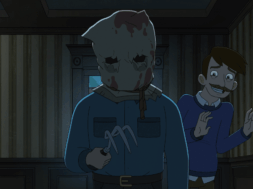You are standing in a hallway, inside a labyrinthine police department. There are, apparently, two ways to choose: you can go straight-forward for the stairs or turn right and enter some possible dangerous rooms. But hey, useful items could be waiting. The lights are out, of course, you have your tiny flashlight and a handgun with scarce ammunition. So you start to focus on your ears. Some zombies are groaning near the stairs, so you choose the rooms first. But when you are getting near the first door, that perturbing licker’s shriek paralyzes you for a second. Your mental strain starts to increase while you are shouting a big “NOPE” and turning the other way around for the stairs. Luckily enough, when you arrive to the first step, avoiding the zombies without getting bitten, a heavy percussion starts playing. Guess who’s descending the stairs: it’s your big boy, Mr. X (and he’s gon give it to ya).
So now you are squashed with the sounds and noises made by zombies, lickers and Mr. X, all of them hitting hard in your poor brain, affecting your decisions. The stress is almost unbearable, escaping without injury or worse seems unlikely. You give your back to Mr. X, but those heavy footsteps are haunting you: you know it’s there, coming for a good taste of your pain. These fine folk are ready to take a piece of you. Nevertheless, maybe by pure chance, you remember a flashbang in your inventory and now everyone is blind. You turn around again, go up the stairs and find a frigging save point. Time to close the game, put on some Fortnite’s dance videos and let your mind release all the stress generated in just five damn minutes.
The example described above is what I like most about the fabulous remake of the all-time classic Resident Evil 2. This remake is a recreation of an almost perfect survival horror. One that not only maintains what made the original so iconic but also takes notes from all the modern horror games that have released since 1998. RE2R’s journey feels nostalgic while giving a complete and engaging new experience at the same time. I could spend paragraphs writing about the incredible graphics engine, the outstanding map design, the improvements in the gameplay and other aspects. But I won’t. I only want to show you why the sound design and the music selected is what makes this game a wild ride.

Let’s read this interesting study from Carleton University about the sound and music in both The Texas Chainsaw Massacre (1974) and Halloween (1978). “[…] sound plays an even greater role in the narrative than the visual, on the basis that much of the killer’s movements are communicated through sound. Horror plays on the audience’s fear of the unknown, and sound plays a huge role in this”. First of all, we don’t have a single enemy (at least, one we fight against) that speaks our language: they make unreal sounds and they can be quite deceiving the first time you come across them. “As humans are very visually oriented beings, it is a bit disorienting to be unable to match an image to a sound”. Nevertheless, when you get used to the noises and you associate its possible sources, you can still be afraid. A creature which is special regarding this aspect is Mr. X. He works as “the acousmetre”, someone who can be heard but not seen from time to time. When he’s near your actual room, you start hearing his deafening footsteps and you’ll probably start panicking. Acousmetre beings make you feel terrified because they are usually depicted as powerful creatures (and his fists do hurt, you know). The use of “acousmatic sound”, a sound produced without a visible source on screen, creates the anxious fear of “something is coming for me”.
Music isn’t left behind. The use of non-diegetic music, with atonal and dissonant tracks, helps to create the frightening environment the developers want. A huge contrast to this happens when you are in a “safe room” and a sweet and slow piano melody starts playing. It brings a little moment of peace and it helps you in chilling for a bit. This use of contrasting sounds can create an “emotional dissonance” within the player, because you might have been running for your life seconds ago, and then the track asks you to “calm down”. Silence in some chambers also helps to create the feeling of isolation: you are alone here, in this bloody hell, and no one is coming to give you a hand.
Last but not least, the voices and reactions of Leon and Claire are key elements in this recipe. You hear them swearing, shouting, screaming and feeling afraid when things start going to hell. These characters feel like real humans, and that allows us to feel empathetic towards them: they are just the unluckiest rookie in the police history, and a young woman trying to find his lost brother. They are scared, yet they are willing to come through the nightmare with our fingers’ help.
Although everything regarding sound and music in RE2R is near perfection, I think there is room for a “small” improvement. One that will possibly make you hate me just for the sake of thinking about it, but I’ll take my chances. Here it goes: whenever you are in a room with creatures, a score will start playing. Mr. X and the monster plants have specific ones, while the zombies have different tunes. Every time you are in an empty room, there’s no music in the air. You could call these the “break moments” in the safe rooms between the peaks of tension. They are nice, and you are quite grateful for them.

However, I have something different in mind. A masochist improvement could be the subversion of this expectation of sounds (not everywhere, because we would end up getting crazy or going to the psychiatrist for meds). Imagine dwelling a room and hearing Mr. X’s percussion, but actually, he is nowhere to be found. Or the other way around: you are quietly searching for a key in a library, no music, no sound besides your footsteps, and out of the blue a zombie is coming in front of you without any previous warning. This subversion of sound expectation could be played in some specific areas and put you in a nerve-breaking situation.
We could use Ivan Pavlov’s* (the guy that experimented with non-zombies dogs) studies for a quick explanation about how this subversion could work. Every time we hear the heavy percussion and Mr. X appears, we learn a “conditioned reflex”: we produce a specific response (“oh no, Mr. X is coming”) to a specific stimulus (the percussion). The same happens with the zombie’s moaning and every sound or music that starts playing in the same conditions. Imagine what the RE Team could do with your mind if they decide to create conditioned reflexes and undoing them in random moments. We would never be with peace of mind. Oh Lord, the horror.
*Please note that Pavlov’s studies are classic ones and Behaviorism is just one branch of Psychology that leaves several factors behind. This study was used with didactic purposes in mind.









